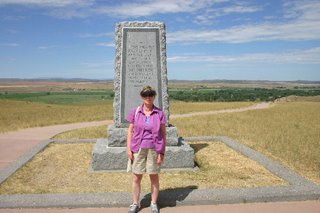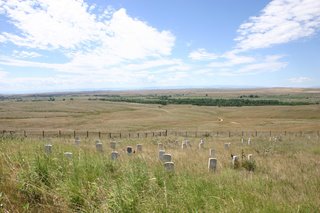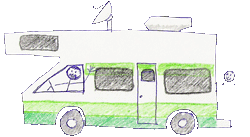

Well, I finally made it to see for myself. And Custer is dead! The national monument is well done, informative and interesting. Of course they put the positive spin on most things. Like pointing out his graduating from West Point, but failing to point out he finished last in his class. Like pointing out his rapid rise to general in the civil war, but failing to point out the only maneuver he used was to charge his enemy, without understanding their strength. Like pointing out Custer was interested in many things, but failing to mention he was not intelligent or a good student. He did like to fight, thought he was invincible and was lucky to a point.
Custer set the stage for his massacre by dividing up his forces. This was done with the full knowledge of the size of the enemy camp, which was scouted by Custer’s Crow scouts. The Sioux, Cheyenne and Arapahoe gathering was one of the largest meetings of the Plains Indians ever. About 8000 people total and 1500 to 2000 warriors were in camp that day. They were camped in the Little Bighorn valley, just west of the river which runs north-south here. Custer started out with 600 + Cavalry. When he got close to the encampment, he divided his forces into four groups. He commanded the largest group, a little over 200. He sent the Maj. Reno group to attack the village from the south, up the Little Bighorn River. Capt Benteen was sent further south and west to look for Indians trying to escape! Custer led his group around the ridge to the north and east of the camp. Custer saw Reno’s charge and rebuff by about 1000 warriors from this ridge. Reno was pushed across the river and made the high ground of the ridge with about 40 men killed. These warriors continued to attack Reno’s group until they became aware of Custer’s group, at which time they left to attack him.
Custer split his group in two, with Capt Keogh staying on the ridge and Custer going down a draw to the river, opposite the camp. That is when the Indians became aware of Custer’s group and sent word to the warriors attacking Reno to come back. The first major Indian attack hit the Capt Keogh group on the ridge. The fierce chief Gall attacked and overran this position quickly. Custer tried to get back to Keogh, but didn’t get there in time. He stopped on what is now known as Custer Hill about ½ mile away. The remaining men from the Keogh group tried to make it to Custer Hill, but almost all of them were killed going that ½ mile. About the time Gall was overrunning Keogh’s position, Crazy Horse lead a major attack up the draw that Custer had gone down and retreated up again. The remaining 100+ men under Custer didn’t last long with two attacks coming from north and south. Altogether, 210 men died on that ridge on the afternoon of June 25, 1876.
While Custer was occupying the warriors, Benteen’s group and the supply train arrived at Reno’s position on the ridge. This is about 5 miles south of Custer Hill. With this force of 350+ men and supplies, Reno was able to hold off the warriors when they returned late in the afternoon after defeating Custer. They continued to hold their ground until the Sioux camp broke up and dispersed the next day, June 26. This was caused by another army group coming up the Little Bighorn River from the north. This army relieved the Reno-Benteen group.
The photo with Priscilla is taken from the Reno defensive position, looking west, down on the Little Bighorn River and valley. The trees mark the river and the Sioux camp would have filled the valley on the other side of the river.
The other photo is taken from Custer Hill, looking toward the river and valley. The white head stones mark where soldiers fell. While most are near the top of the hill, many are seen down the hill as well. Custer’s headstone is in black, in the middle on the hill top.
And thanks to Ken Atkins, who lent me his copy of “Son of the Morning Star”, a history of Custer and the Little Bighorn battle. I had it read and digested before getting here.
I failed to mention we traveled here on July 6 and toured the monument today the 7th.







1 Comments:
At July 10, 2006 7:34 PM, Anonymous said…
Anonymous said…
John...Nice job on the narrative of the battle. And on Custer and his arrogance. It's a great story and I'm sure so many young people today have no knowledge of that period of the Indian Wars and how good the indians were as horsemen and fighters.
I think your photos at the Battlefield give a great testimony to why they call Montana the "Big Sky" country. Looks like you had a magnificent day for your visit.
We miss you guys.
Ken
Post a Comment
<< Home